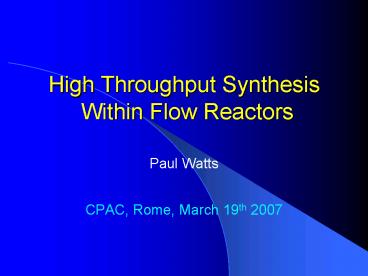High Throughput Synthesis Within Flow Reactors PowerPoint PPT Presentation
1 / 24
Title: High Throughput Synthesis Within Flow Reactors
1
High Throughput Synthesis Within Flow Reactors
- Paul Watts
- CPAC, Rome, March 19th 2007
2
Micro Reactors
- Defined as a series of interconnecting channels
formed in a planar surface - Channel dimensions of 10-300 mm
- Various pumping techniques available
- Hydrodynamic flow
- Electroosmotic flow
- Fabricated from polymers, metals, quartz, silicon
or glass - Why glass?
- Mechanically strong
- Chemically resistant
- Optically transparent
3
PET Radiosynthesis
- Positron emission tomography (PET) is a
radiotracer imaging technique used to provide
quantitative information on physiological and
biochemical phenomena in vivo - Applications in clinical research and drug
discovery - Two of the most desirable radioisotopes are
- 11C (t1/2 20.4 minutes)
- 18F (t1/2 109.7 minutes)
- Syntheses must be conducted within 2-3 half-lives
- Aims of miniaturisation
- Produce the desired quantity of radiotracer (lt 1
mg) at point of use - Reduced reaction times will produce the product
with enhanced specific activity - The PET ligand will have greater sensitivity in
vivo
Collaboration with NIH, Washington DC
4
PET Chemistry
- Reaction of 3-(3-pyridinyl)propionic acid
- Reaction optimised with 12CH3I (10 mM
concentration) at RT - Hydrodynamic flow (syringe pump)
- Reaction with 11CH3I
- At 0.5 ml/min flow rate RCY 88
- Reaction of 18FCH2CH2OTs at 80 oC
- At 0.5 ml/min flow rate RCY 10
Lab Chip, 2004, 4, 523
5
PET Chemistry
- Esterification reaction
- Reaction with 11CH3I (10 mM concentration) at RT
- RCY 65 at 0.5 ml/min flow rate
- Product isolated by preparative HPLC
Lab Chip, 2004, 4, 523
6
Electroosmotic Flow (EOF)
- Advantages of EOF
- No mechanical parts
- Reproducible, pulse free flow
- Minimal back pressure
- Electrophoretic separation
- See Chem. Commun., 2003, 2886 for peptide
separation
7
18F PET Chemistry
- 18F has a longer half-live than 11C
- Produced from H218O
- For nucleophilic reactions the fluoride needs to
be separated from the water - Azeotropic distillation
- Electrophoretic separation
- Reaction
Electrophoresis
18F-
J. Lab. Compd. Radiopharm., 2007, 50, in press
8
Stable Radiosynthesis
- Stable isotopes routinely used in drug discovery
for drug metabolism studies (500 mg typically
needed) - Amide synthesis
- Optimise reaction with normal (cheap)
unlabelled reagents
9
Stable Radiosynthesis
- Acetylation of aniline
- Reaction efficiency dependent of flow rate
- Reaction repeated with other derivatives
10
Stable Radiosynthesis
- Once optimised substitute labelled precursor
J. Lab. Compd. Radiopharm., 2007, 50, 189-196
11
Electrosynthesis - Kolbe Reaction
- Radical dimerisation (Kolbe reaction)
- Reactor diameter 1 mm
- 1 mm platinum electrodes separated by 1 mm
- Surface area in cell ca. 3 mm2
- Current 5 mA cm-2
12
Reaction Efficiency
- Reaction conducted continuously for 12 hours
- A base is needed to deprotonate the acid
- Pyridine most successful
- Stops contamination of electrode surface
- Also works for other dimerisation reactions
13
Electrochemical Debrominations
- Parallel plate electrochemical reactor
- Electrode area 25 mm2
- Electrodes 160 mm apart
- Flow rate 40 ml min-1
14
Coupling Reactions
Flow Rate 10 ml min-1
Electro. Commun., 2005, 7, 918 Angew. Chem. Int.
Ed., 2006, 45, 4146 Green Chem., 2007, 9,
20 Lab. Chip, 2007, 7, 141
15
Fine Chemical Synthesis
- New methodology for fine chemical synthesis
- Enhanced yields of more pure products etc
16
Knoevenagel Reaction
- Solution phase Knoevenagel reaction
- 11 Ratio of reagents (0.5 M) in MeCN
- EOF
- 100 conversion
- Reaction very atom efficient
- BUT product contaminated with base!!
- Traditional solvent extraction needed
- This clearly reduces the advantages of flow
reactors
17
Functionally Intelligent Reactors
- Fabricate micro reactors which enable catalysts
and/or supported reagents to be spatially
positioned - Quantitative conversion to analytically pure
product
18
Multi-Step Synthesis
19
Enzymatic Reactions
- Enzymatic esterification
- Flow reactor
- Reaction Conditions
- Acid Hexanoic acid, octanoic acid or lauric acid
- Alcohol Methanol, Ethanol or Butanol
- 11 ratio in hexane (0.2 M)
- Room temperature
20
Synthesis of Butyl Hexanoate
- Esterification reaction is equilibrium dependent
- With time conversion can increase then decrease
- In flow the reaction mixture is removed so
equilibrium is controlled - 96 yield
- Gain knowledge about substrate specificity
- Link solution phase and catalysed reactions
21
Scale Out and Catalyst Screening
- Scale-out of reactions
- 4 channels operating in parallel produces 4 times
the product - Larger packed reactors also feasible (5 mm
diameter) - Synthesise arrays of compounds
22
Combinations of Acids and Bases
23
Conclusions
- Micro reactors allow the rapid optimisation of
reactions - High-throughput combinatorial synthesis
- Immobilised reagents (catalysts and enzymes)
allow the synthesis of analytically pure
compounds - Micro reactors are suitable for a wide range of
reactions - Electrochemical synthesis
- Catalysed reactions
- Enzyme screening
- Micro reactors generate products in
- Higher purity
- Higher conversion
- Higher selectivity
- In situ formation of reagents
P. D. I. Fletcher et al., Tetrahedron, 2002, 58,
4735 K. Jahnisch et al., Angew. Chem. Int. Ed.,
2004, 43, 406 H. Pennemann et al., OPRD, 2004, 8,
422 P. Watts et al., Chem. Soc. Rev., 2005, 34,
235
24
Research Workers and Collaborators
- Dr. Charlotte Wiles
- Dr. Nikzad Nikbin
- Dr. Ping He
- Dr. Victoria Ryabova
- Dr. Vinod George
- Dr. Leanne Marle
- Dr. Joe Dragavon
- LioniX
- Astra Zeneca
- Novartis
- Mairead Kelly
- Gareth Wild
- Tamsila Nayyar
- Julian Hooper
- Linda Woodcock
- Haider Al-Lawati
- Ben Wahab
- EPSRC
- Sanofi-Aventis
- EU FP6

